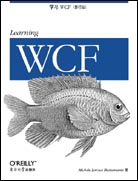
学习 WCF(影印版)
出版时间:2007年12月
页数:558
“就如同从古罗马诗人维吉尔开始一路讲到但丁一样,Michele会带着你由浅入深,关注实用和真实的案例,避开神神鬼鬼的陷阱,顺利走遍WCF……当完成旅途之时,你将成为WCF专业开发者群体中的一员,只有他们才能以WCF的方式使用WCF。”
—— Ted Neward,http://www.tedneward.com
这本易学易用的书是为那些想要透彻掌握微软Windows Communication Foundation(WCF)新框架以创建面向服务的应用程序的中高级开发者们所编写的。
《学习WCF》包含100多个代码样例、20多个实验以及针对开发者常见问题的详细解答。通过这些,《学习WCF》征服了这个新平台的一切复杂问题。从基础概念到高级场景,该书无疑能加深你在如下各个重要方面的相关知识:
· 合约——学习设计服务合约、为复杂类型的序列化创建数据合约、使用其他可序列化类型以及执行自定义序列化以处理合约优先与合约版本化场景。
· 绑定——揭示每个内网或者互联网应用程序的核心绑定的实际用途,并学会如何自定义那些特定场景的绑定配置,例如大型消息和流的处理。
· 宿主——了解多种宿主环境的合适用途和相应好处,包括Windows应用、Windows服务、IIS和Windows激活服务。
· 实例与并发——将服务配置成singleton运行,以提供应用会话支持或作为可扩展的无会话服务,并且学习如何管理吞吐量和抑制请求。
· 可靠性——应用诸如可信赖会话、分布式事务和队列消息等功能。
· 安全性——了解WCF如何支持双向认证和消息保护的基本安全需求、学习如何管理运行时身份、探索多种授权模式等。
· 异常和错误——学习错误处理相关概念,包括调试技巧、异常管理和错误合约。
若想迅速掌握这项新技术,你所需要的就是《学习WCF》。
—— Ted Neward,http://www.tedneward.com
这本易学易用的书是为那些想要透彻掌握微软Windows Communication Foundation(WCF)新框架以创建面向服务的应用程序的中高级开发者们所编写的。
《学习WCF》包含100多个代码样例、20多个实验以及针对开发者常见问题的详细解答。通过这些,《学习WCF》征服了这个新平台的一切复杂问题。从基础概念到高级场景,该书无疑能加深你在如下各个重要方面的相关知识:
· 合约——学习设计服务合约、为复杂类型的序列化创建数据合约、使用其他可序列化类型以及执行自定义序列化以处理合约优先与合约版本化场景。
· 绑定——揭示每个内网或者互联网应用程序的核心绑定的实际用途,并学会如何自定义那些特定场景的绑定配置,例如大型消息和流的处理。
· 宿主——了解多种宿主环境的合适用途和相应好处,包括Windows应用、Windows服务、IIS和Windows激活服务。
· 实例与并发——将服务配置成singleton运行,以提供应用会话支持或作为可扩展的无会话服务,并且学习如何管理吞吐量和抑制请求。
· 可靠性——应用诸如可信赖会话、分布式事务和队列消息等功能。
· 安全性——了解WCF如何支持双向认证和消息保护的基本安全需求、学习如何管理运行时身份、探索多种授权模式等。
· 异常和错误——学习错误处理相关概念,包括调试技巧、异常管理和错误合约。
若想迅速掌握这项新技术,你所需要的就是《学习WCF》。
- Forewords
- Preface
- 1. Hello Indigo
- Service Oriented Architecture
- WCF Services
- Fundamental WCF Concepts
- Creating a New Service from Scratch
- Generating a Service and Client Proxy
- Hosting a Service in IIS
- Exposing Multiple Service Endpoints
- Summary
- 2. Contracts
- Messaging Protocols
- Service Description
- WCF Contracts and Serialization
- Service Contracts
- Data Contracts
- Message Contracts
- Approaches to Serialization
- The Message Type
- Summary
- 3. Bindings
- How Bindings Work
- Web Service Bindings
- Connection-Oriented Bindings
- One-Way and Duplex Communication
- Large Message Transfers
- Custom Bindings
- Summary
- 4. Hosting
- Hosting Features
- ServiceHost
- Self-Hosting
- Hosting on the UI Thread
- Hosting in a Windows Service
- Hosting in IIS 6.0
- IIS 7.0 and Windows Activation Service
- Choosing the Right Hosting Environment
- Summary
- 5. Instancing and Concurrency
- OperationContext
- Instancing
- Concurrency
- Instance Throttling
- Load Balancing and Failover
- Summary
- 6. Reliability
- Reliable Sessions
- Transactions
- Queued Calls
- Summary
- 7. Security
- WCF Security Overview
- Securing Intranet Services
- Securing Internet Services
- Working with Certificates
- Building a Claims-Based Security Model
- Exploring Federated Security
- Summary
- 8. Exceptions and Faults
- SOAP Faults
- WCF Exception Handling
- Exceptions and Debugging
- Fault Contracts
- IErrorHandler
- Summary
- A. Setup Instructions
- B. ASP.NET Meets CardSpace
- Index
书名:学习 WCF(影印版)
国内出版社:东南大学出版社
出版时间:2007年12月
页数:558
书号:978-7-5641-0961-5
原版书出版商:O'Reilly Media
The animal on the cover of Learning WCF is a marine fish commonly referred to as a damselfish (demoiselle). Damselfish and clownfish comprise the family Pomacentridae and are found in tropical waters throughout the world, though mainly in the Atlantic and Indo-Pacific oceans. The damselfish, of which there are about 250 species, has a deep, compressed body, a small mouth, and an anal fin with two (occasionally three)spines. Its average length in captivity is about 2 inches, but in the wild, the largest member of this subfamily reaches over 14 inches.Coloration varies according to species, location, and age; these fish often lose their brightness as adults.
Because damselfish are extremely hardy, they are often captured and bred in aquariums.They are sometimes used to break in a new aquarium, but this is considered an old-school practice and is frowned upon by advanced aquarists. In captivity,damselfish can become quite aggressive among themselves and toward other tankmates,disrupting an otherwise peaceful environment. In the wild, they tend to stay in small schools while young and eventually break away to become solitary as adults.
Some damselfish live with anemones in a comensal relationship, meaning that each party benefits from the arrangement. In its natural habitat, this entertaining little fish can live up to 20 years.
Because damselfish are extremely hardy, they are often captured and bred in aquariums.They are sometimes used to break in a new aquarium, but this is considered an old-school practice and is frowned upon by advanced aquarists. In captivity,damselfish can become quite aggressive among themselves and toward other tankmates,disrupting an otherwise peaceful environment. In the wild, they tend to stay in small schools while young and eventually break away to become solitary as adults.
Some damselfish live with anemones in a comensal relationship, meaning that each party benefits from the arrangement. In its natural habitat, this entertaining little fish can live up to 20 years.
购买选项